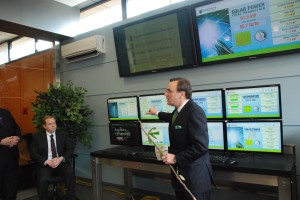 Saint Peter’s University is “going green.” Since signing The American College and University Presidents’ Climate Commitment in 2008, University President Eugene J. Cornacchia, Ph.D., has spearheaded several green energy initiatives on campus. The latest, the Green Energy Command Center, monitors the impact of these projects 24 hours a day by tracking the amount and type of energy being used on campus, the total amount of energy savings and data on the carbon saving benefits. The latter, for example, is prominently displayed on one of several screens in the Command Center and charts the amount of carbon dioxide savings at the University. The amount is equivalent to 1,627 planted trees since the Green Energy Command Center opened early in 2013.
Saint Peter’s University is “going green.” Since signing The American College and University Presidents’ Climate Commitment in 2008, University President Eugene J. Cornacchia, Ph.D., has spearheaded several green energy initiatives on campus. The latest, the Green Energy Command Center, monitors the impact of these projects 24 hours a day by tracking the amount and type of energy being used on campus, the total amount of energy savings and data on the carbon saving benefits. The latter, for example, is prominently displayed on one of several screens in the Command Center and charts the amount of carbon dioxide savings at the University. The amount is equivalent to 1,627 planted trees since the Green Energy Command Center opened early in 2013.
To inaugurate the state-of-the-art facility, Dr. Cornacchia, Jersey City Mayor Jerramiah Healy, Councilwoman-at-Large Viola S. Richardson, and representatives from Strategic Development Group, ENER-G and Emacx Systems Inc. joined together to cut the ribbon for the official opening of the Green Energy Command Center on February 20.
“It is great to be here today for another positive step for Saint Peter’s University,” said Mayor Healy. “Saint Peter’s has been looking at the possibilities of shrinking their carbon footprint. It’s kind of parallel to what we’ve been doing in Jersey City.”
 The Green Energy Command Center, located in the lower level of Dinneen Hall, serves as the nucleus of Saint Peter’s green energy efforts, a facility filled with software and equipment that tracks energy usage and savings and carbon waste on campus. The center will also serve as a learning laboratory and will be used as an educational tool for students from a wide range of academic programs.
The Green Energy Command Center, located in the lower level of Dinneen Hall, serves as the nucleus of Saint Peter’s green energy efforts, a facility filled with software and equipment that tracks energy usage and savings and carbon waste on campus. The center will also serve as a learning laboratory and will be used as an educational tool for students from a wide range of academic programs.
“We have built some 1,700 cogeneration and trigeneration projects in Europe, but this is the first in the United States,” stated Chris Hayton, CEO of ENER-G’s USA operations for ENER-G Holdings PLC, a leading European developer and operator of clean, renewable and distributed power generation projects and provider of various clean technology solutions. “Saint Peter’s took and made the commitment to this initiative.”
Following the ribbon cutting, a demonstration of the Command Center was given by Theo Breitenstein, president of Emacx Systems, the company that designed the Green Energy Command Center. Breitenstein explained how the Command Center works and what the various screens in the room monitor, such as weather, solar power and green energy total production. A tour of the Green Energy Plant Room in Pope Hall was subsequently held.
Green energy, which can be harnessed with little pollution, includes anaerobic digestion, geothermal power, wind power, small-scale hydropower, solar energy, biomass power, tidal power, wave power, and some forms of nuclear power. In November 2011, the University began a green energy initiative on its West Campus, which is now in the final stages of completion. The program involved the installation of solar arrays above a number of buildings on the campus to generate electricity. These buildings include Dinneen Hall, Pope Hall, McDermott Hall and The Victor R. Yanitelli, S.J. Recreational Life Center (RLC) parking deck. A cogeneration plant was also built in the basement of Pope Hall that produces both low carbon heat and electricity for academic buildings on the West Campus.
 “As a Jesuit, Catholic institution, Saint Peter’s strongly believes in being a good steward of God’s creation, and has sought cutting-edge science to assist in the goal of reducing the carbon footprint of the University,” said Dr. Cornacchia.
“As a Jesuit, Catholic institution, Saint Peter’s strongly believes in being a good steward of God’s creation, and has sought cutting-edge science to assist in the goal of reducing the carbon footprint of the University,” said Dr. Cornacchia.
He added, “Spanning our West Campus, with plans currently underway for the East Campus, Saint Peter’s green energy initiative will reduce our carbon footprint by more than 40 percent and provide significant energy savings for years to come.”
To view additional photos from the event, please click here.

